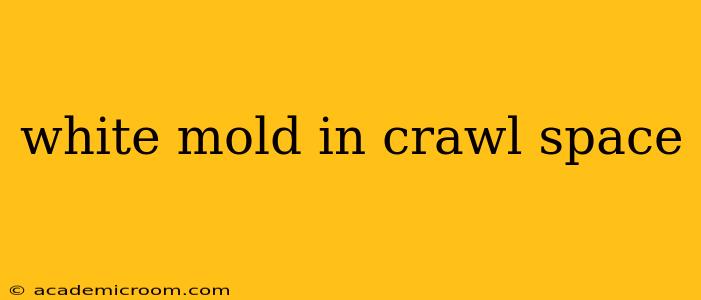Discovering white mold in your crawl space can be alarming, but understanding its causes and how to address it is crucial for maintaining a healthy home environment. This comprehensive guide will equip you with the knowledge to identify, prevent, and remediate white mold growth in your crawl space. Remember, while this guide provides helpful information, consulting with a professional mold remediation specialist is always recommended, particularly for extensive infestations.
What is White Mold?
White mold isn't a single type of mold but rather a general term for various fungi exhibiting a white or light-colored appearance. Common types found in crawl spaces include Serpula lacrymans (dry rot), Coniophora puteana (wet rot), and various species of Fusarium. These molds thrive in damp, humid conditions and often appear fuzzy or cottony. Crucially, all mold should be treated seriously, as even seemingly innocuous white mold can produce allergens and irritants affecting respiratory health, especially for those with sensitivities.
What Causes White Mold in a Crawl Space?
Several factors contribute to white mold growth in crawl spaces. Addressing these root causes is vital for effective remediation and preventing future infestations.
High Humidity Levels: High humidity provides the ideal environment for mold spores to germinate and grow. Moisture from leaking pipes, inadequate ventilation, or ground moisture can significantly increase humidity.
Poor Ventilation: Insufficient airflow in a crawl space traps moisture, creating a breeding ground for mold. A properly ventilated crawl space allows for air circulation, reducing humidity and preventing mold growth.
Water Leaks: Leaking pipes, roof leaks, or groundwater seepage are significant contributors to mold growth. Identifying and repairing these leaks is paramount.
Condensation: Cold surfaces within the crawl space can cause condensation, providing moisture for mold growth, particularly during temperature fluctuations.
Insufficient Insulation: Lack of proper insulation allows for temperature fluctuations, leading to condensation and increased humidity.
How to Identify White Mold in a Crawl Space?
Identifying white mold requires careful observation. Look for:
- White or light-colored patches: These patches can be fuzzy, cottony, or powdery in texture.
- Musty odor: Mold often emits a distinct musty smell.
- Dampness: White mold thrives in damp areas; check for wet wood, soil, or other materials.
How to Get Rid of White Mold in a Crawl Space?
Attempting DIY mold remediation can be risky, especially for large infestations. However, for small, localized areas, you can take the following steps:
-
Safety First: Wear protective gear including an N95 respirator mask, gloves, and eye protection before attempting any cleaning.
-
Remove Affected Materials: Carefully remove any visibly moldy materials, such as wood, drywall, or insulation. Dispose of these materials properly according to local regulations.
-
Clean the Area: Use a solution of water and detergent to scrub the affected area. Thoroughly dry the area afterward.
-
Improve Ventilation: Ensure adequate ventilation by installing vents or improving existing ventilation systems.
-
Reduce Humidity: Consider using a dehumidifier to reduce moisture levels in the crawl space.
Is White Mold Dangerous?
Can white mold make you sick? Yes, exposure to white mold, like any mold, can trigger allergic reactions, such as sneezing, coughing, and skin irritation. Individuals with pre-existing respiratory conditions may experience more severe symptoms. Some molds also produce mycotoxins, which can cause more serious health problems.
Is white mold toxic? While not all white molds are toxic, some species produce mycotoxins, which are poisonous substances. The toxicity of a particular mold species depends on various factors.
What are the health risks of white mold? Health risks associated with white mold exposure vary based on individual sensitivity and mold species. Potential risks include allergic reactions, respiratory problems, and in severe cases, more serious health complications from mycotoxin exposure.
How do I prevent white mold in my crawl space? Prevention is key. Maintain proper ventilation, address water leaks promptly, ensure sufficient insulation, and utilize a dehumidifier to keep humidity levels low. Regular inspections can help detect mold early.
When to Call a Professional?
If you have a large mold infestation, suspect a significant source of moisture, or experience health issues related to mold exposure, contact a qualified mold remediation specialist immediately. Professionals possess the expertise and equipment to safely and effectively remove mold and address the underlying causes. Remember, neglecting mold growth can lead to costly repairs and health problems. Don't hesitate to seek professional assistance when needed.
